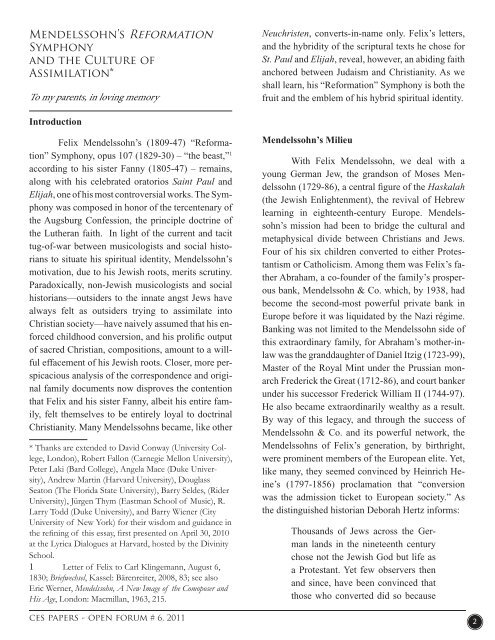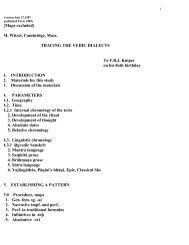references - people.fas.harvard.edu - Harvard University
references - people.fas.harvard.edu - Harvard University
references - people.fas.harvard.edu - Harvard University
You also want an ePaper? Increase the reach of your titles
YUMPU automatically turns print PDFs into web optimized ePapers that Google loves.
Mendelssohn’s Reformation<br />
Symphony<br />
and the Culture of<br />
Assimilation*<br />
To my parents, in loving memory<br />
Introduction<br />
Felix Mendelssohn’s (1809-47) “Reformation”<br />
Symphony, opus 107 (1829-30) – “the beast,” 1<br />
according to his sister Fanny (1805-47) – remains,<br />
along with his celebrated oratorios Saint Paul and<br />
Elijah, one of his most controversial works. The Symphony<br />
was composed in honor of the tercentenary of<br />
the Augsburg Confession, the principle doctrine of<br />
the Lutheran faith. In light of the current and tacit<br />
tug-of-war between musicologists and social historians<br />
to situate his spiritual identity, Mendelssohn’s<br />
motivation, due to his Jewish roots, merits scrutiny.<br />
Paradoxically, non-Jewish musicologists and social<br />
historians—outsiders to the innate angst Jews have<br />
always felt as outsiders trying to assimilate into<br />
Christian society—have naively assumed that his enforced<br />
childhood conversion, and his prolifi c output<br />
of sacred Christian, compositions, amount to a willful<br />
effacement of his Jewish roots. Closer, more perspicacious<br />
analysis of the correspondence and original<br />
family documents now disproves the contention<br />
that Felix and his sister Fanny, albeit his entire family,<br />
felt themselves to be entirely loyal to doctrinal<br />
Christianity. Many Mendelssohns became, like other<br />
* Thanks are extended to David Conway (<strong>University</strong> College,<br />
London), Robert Fallon (Carnegie Mellon <strong>University</strong>),<br />
Peter Laki (Bard College), Angela Mace (Duke <strong>University</strong>),<br />
Andrew Martin (<strong>Harvard</strong> <strong>University</strong>), Douglass<br />
Seaton (The Florida State <strong>University</strong>), Barry Seldes, (Rider<br />
<strong>University</strong>), Jürgen Thym (Eastman School of Music), R.<br />
Larry Todd (Duke <strong>University</strong>), and Barry Wiener (City<br />
<strong>University</strong> of New York) for their wisdom and guidance in<br />
the refi ning of this essay, fi rst presented on April 30, 2010<br />
at the Lyrica Dialogues at <strong>Harvard</strong>, hosted by the Divinity<br />
School.<br />
1 Letter of Felix to Carl Klingemann, August 6,<br />
1830; Briefwechsel, Kassel: Bärenreiter, 2008, 83; see also<br />
Eric Werner, Mendelssohn, A New Image of the Comoposer and<br />
His Age, London: Macmillan, 1963, 215.<br />
ces papers - open forum # 6, 2011<br />
Neuchristen, converts-in-name only. Felix’s letters,<br />
and the hybridity of the scriptural texts he chose for<br />
St. Paul and Elijah, reveal, however, an abiding faith<br />
anchored between Judaism and Christianity. As we<br />
shall learn, his “Reformation” Symphony is both the<br />
fruit and the emblem of his hybrid spiritual identity.<br />
Mendelssohn’s Milieu<br />
With Felix Mendelssohn, we deal with a<br />
young German Jew, the grandson of Moses Mendelssohn<br />
(1729-86), a central fi gure of the Haskalah<br />
(the Jewish Enlightenment), the revival of Hebrew<br />
learning in eighteenth-century Europe. Mendelssohn’s<br />
mission had been to bridge the cultural and<br />
metaphysical divide between Christians and Jews.<br />
Four of his six children converted to either Protestantism<br />
or Catholicism. Among them was Felix’s father<br />
Abraham, a co-founder of the family’s prosperous<br />
bank, Mendelssohn & Co. which, by 1938, had<br />
become the second-most powerful private bank in<br />
Europe before it was liquidated by the Nazi régime.<br />
Banking was not limited to the Mendelssohn side of<br />
this extraordinary family, for Abraham’s mother-inlaw<br />
was the granddaughter of Daniel Itzig (1723-99),<br />
Master of the Royal Mint under the Prussian monarch<br />
Frederick the Great (1712-86), and court banker<br />
under his successor Frederick William II (1744-97).<br />
He also became extraordinarily wealthy as a result.<br />
By way of this legacy, and through the success of<br />
Mendelssohn & Co. and its powerful network, the<br />
Mendelssohns of Felix’s generation, by birthright,<br />
were prominent members of the European elite. Yet,<br />
like many, they seemed convinced by Heinrich Heine’s<br />
(1797-1856) proclamation that “conversion<br />
was the admission ticket to European society.” As<br />
the distinguished historian Deborah Hertz informs:<br />
Thousands of Jews across the German<br />
lands in the nineteenth century<br />
chose not the Jewish God but life as<br />
a Protestant. Yet few observers then<br />
and since, have been convinced that<br />
those who converted did so because<br />
2

















